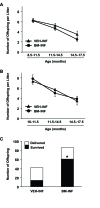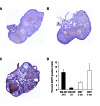Young adult donor bone marrow infusions into female mice postpone age-related reproductive failure and improve offspring survival
- PMID: 20157587
- PMCID: PMC2815764
- DOI: 10.18632/aging.100002
Young adult donor bone marrow infusions into female mice postpone age-related reproductive failure and improve offspring survival
Abstract
The female reproductive axis is the first major organ system of the body to fail with advancing age. In addition to a permanent cessation of fertile potential, the loss of cyclic ovarian function in humans heralds the onset of menopause, which in turn underlies the emergence of a diverse spectrum of health issues in aging women. Recently, it was reported that bone marrow (BM) transplantation (BMT) into adult female mice conditioned a week earlier with highly cytotoxic drugs rescues ovarian function and fertility. Herein we show in mice receiving no prior conditioning regimen that once-monthly infusions of BM-derived cells retrieved from young adult female donors bearing an enhanced green fluorescent protein (EGFP) transgene sustain the fertile potential of aging wild-type females long past their time of normal reproductive senescence. The fertility-promoting effects of female donor BM are observed regardless whether the infusions are initiated in young adult or middle-aged females. Although the mechanism by which BM infusions benefit the reproductive performance of aging females remains to be elucidated, the absence of EGFP-expressing offspring suggests that it does not depend on development of mature eggs derived from germline-committed cells in the donor marrow. However, donor BM-derived somatic cells accumulate in the recipients, indicating efficient donor cell engraftment without prior conditioning. These findings provide a strong impetus to further explore development of adult stem cell-based technologies to safely extend function of the female reproductive axis into advanced age without the need for toxic pre-conditioning protocols routinely used in other models of stem cell delivery.
Keywords: aging; bone marrow; fertility; menopause; ovary; reproduction; stem cell.
Conflict of interest statement
The authors have no conflict of interests to declare.
Figures






Similar articles
-
Bone marrow transplantation generates immature oocytes and rescues long-term fertility in a preclinical mouse model of chemotherapy-induced premature ovarian failure.J Clin Oncol. 2007 Aug 1;25(22):3198-204. doi: 10.1200/JCO.2006.10.3028. J Clin Oncol. 2007. PMID: 17664466
-
The contribution of cytotoxic and noncytotoxic function by donor T-cells that support engraftment after allogeneic bone marrow transplantation.Biol Blood Marrow Transplant. 2002;8(11):588-96. doi: 10.1053/bbmt.2002.v8.abbmt080588. Biol Blood Marrow Transplant. 2002. PMID: 12463477
-
A Murine 5-Fluorouracil-Based Submyeloablation Model for the Study of Bone Marrow-Derived Cell Trafficking in Reproduction.Endocrinology. 2016 Oct;157(10):3749-3759. doi: 10.1210/en.2016-1418. Epub 2016 Jul 18. Endocrinology. 2016. PMID: 27427897 Free PMC article.
-
Reproductive potential in the older woman.Fertil Steril. 1986 Dec;46(6):989-1001. doi: 10.1016/s0015-0282(16)49869-9. Fertil Steril. 1986. PMID: 3536609 Review.
-
Chimerism and tolerance: from freemartin cattle and neonatal mice to humans.Hum Immunol. 1997 Feb;52(2):155-61. doi: 10.1016/S0198-8859(96)00290-X. Hum Immunol. 1997. PMID: 9077564 Review.
Cited by
-
Novel view of the adult stem cell compartment - a developmental story of germline and parental imprinting.Proc Stem Cell Res Oncog. 2019;7:e1001. Epub 2019 Jun 17. Proc Stem Cell Res Oncog. 2019. PMID: 32699838 Free PMC article.
-
Oogonial stem cells as a model to study age-associated infertility in women.Reprod Fertil Dev. 2015 Jul;27(6):969-74. doi: 10.1071/RD14461. Reprod Fertil Dev. 2015. PMID: 25897831 Free PMC article. Review.
-
Estrogen regulation of germline stem cell differentiation as a mechanism contributing to female reproductive aging.Aging (Albany NY). 2020 Apr 17;12(8):7313-7333. doi: 10.18632/aging.103080. Epub 2020 Apr 17. Aging (Albany NY). 2020. PMID: 32302290 Free PMC article.
-
Making gametes from alternate sources of stem cells: past, present and future.Reprod Biol Endocrinol. 2017 Nov 16;15(1):89. doi: 10.1186/s12958-017-0308-8. Reprod Biol Endocrinol. 2017. PMID: 29145898 Free PMC article. Review.
-
Effects of Portulaca oleracea ethanolic extract on reproductive system of aging female mice.Int J Reprod Biomed. 2016 Mar;14(3):205-12. Int J Reprod Biomed. 2016. PMID: 27294220 Free PMC article.
References
-
- Buckler H. The menopause transition: endocrine changes and clinical symptoms. J Br Menopause Soc. 2005;11:61–65. - PubMed
-
- Richardson SJ, Senikas V, Nelson JF. Follicular depletion during the menopausal transition: evidence for accelerated loss and ultimate exhaustion. J Clin Endocrinol Metab. 1987;65:1231–1237. - PubMed
-
- Gosden RG, Laing SC, Felicio LS, Nelson JF, Finch CE. Imminent oocyte exhaustion and reduced follicular recruitment mark the transition to acyclicity in aging C57BL/6J mice. Biol Reprod. 1983;28:255–260. - PubMed
Publication types
MeSH terms
Substances
Grants and funding
LinkOut - more resources
Full Text Sources
Other Literature Sources
Medical
Miscellaneous
